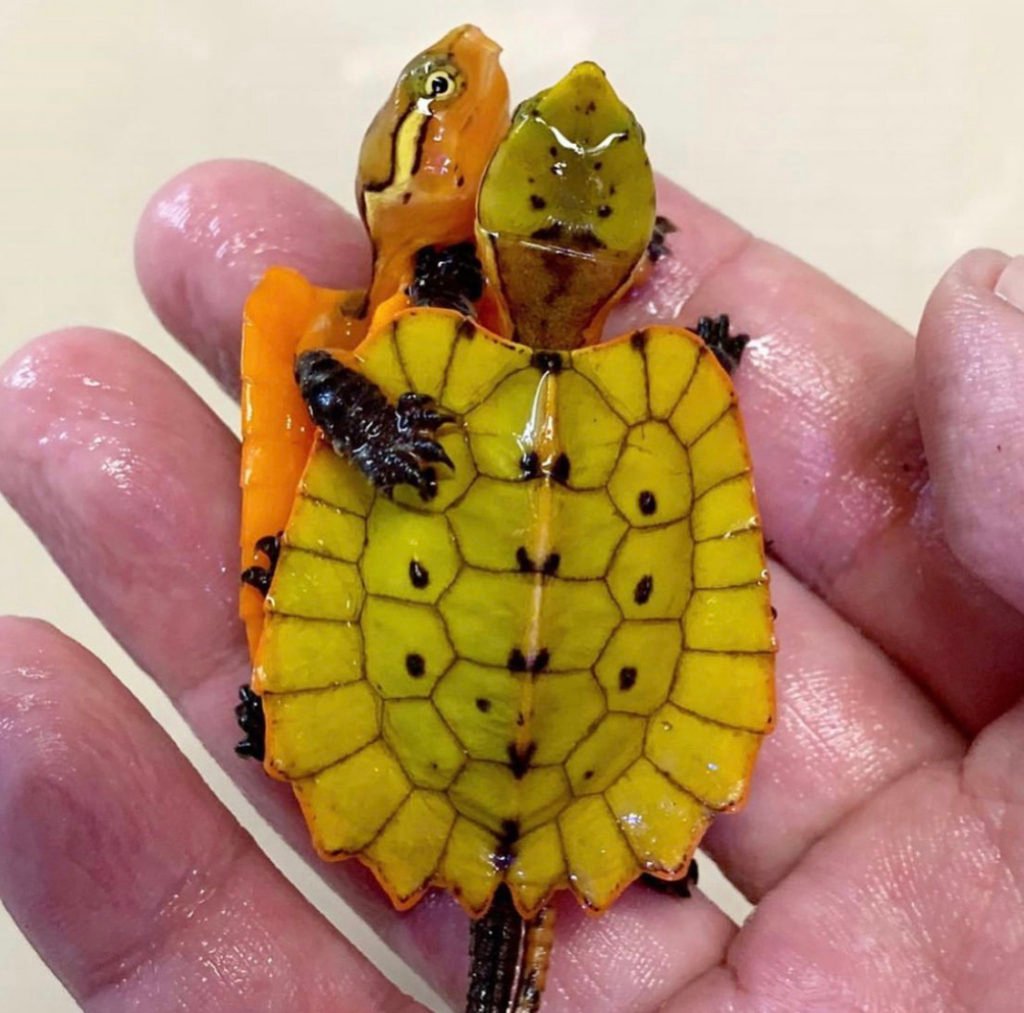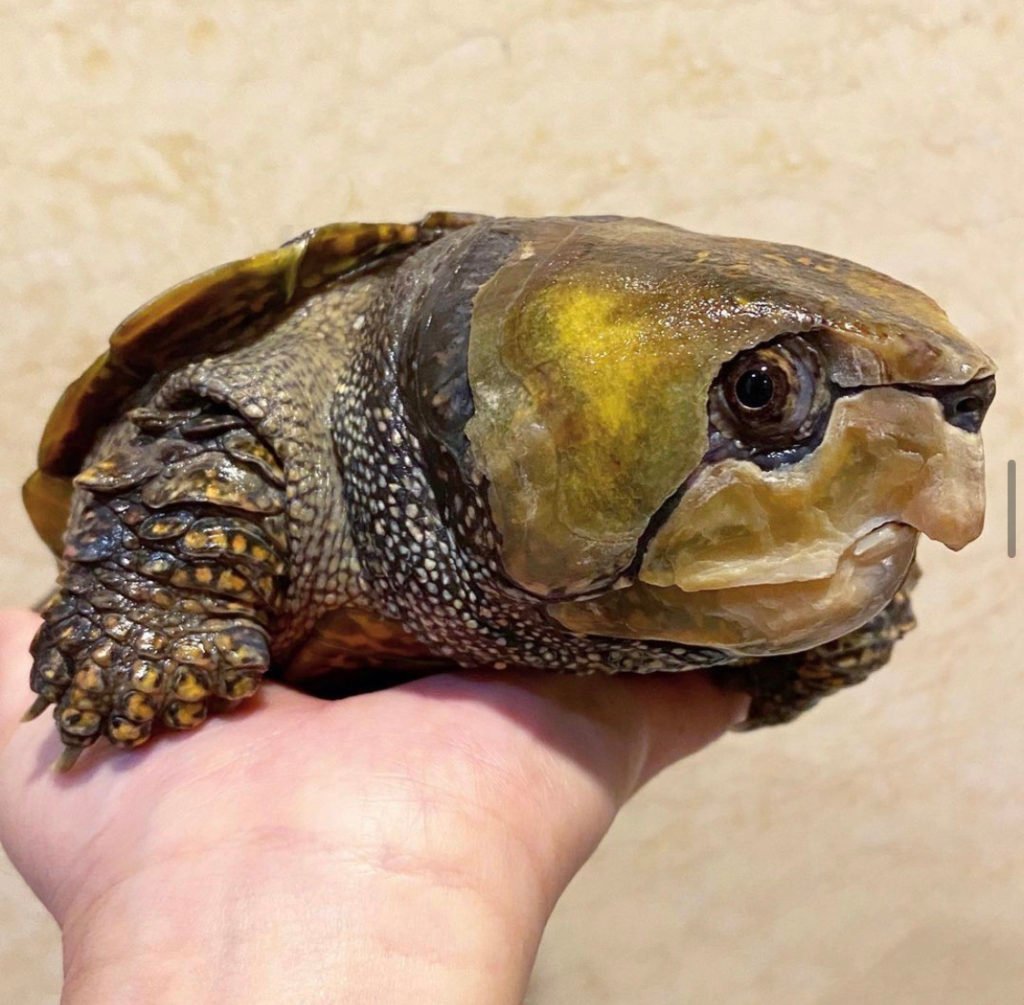Are you looking for a pet that’s a little out of the ordinary?
Then consider the Big Headed Turtle, a fascinating species gaining popularity among pet owners. This article will explore why this unusual creature may appeal to you as a potential pet.
The Appeal of the Big Headed Turtle
While dogs and cats may be the go-to pets for many people, some are looking for something different. That’s where the Big-Headed Turtle comes in. For those seeking a non-traditional pet, this species’ unusual look, intriguing activity, and low upkeep may be ideal.

Big Headed Turtle Physical Characteristics
The Big-Headed Turtle (Platysternon megacephaly) is a freshwater Turtle native to Southeast Asia. As its name suggests, it is known for its enormous head compared to its body size.
Size
Big-Headed Turtles are little turtles, averaging 12 inches (30 cm) long. They stand out from other species due to their big heads and flattened shells.
Head
The Big-Headed Turtle’s head is almost half its length. The Turtle’s enormous head is a unique adaption that helps it crack its prey’s hard shells, including snails and crustaceans.
Shell
In addition to its large head, the Big-Headed Turtle’s shell is also unique. It is flattened and smooth, with a distinct hump in the center of the carapace. The carapace is usually brown or black and has a specific pattern of markings that can vary between individuals.
Limbs and Tail
The Big-Headed Turtle has four webbed limbs and a long, muscular tail that helps it move through the water. Its feet are well-adapted for swimming, with large claws that let it grip surfaces and move more efficiently.
You may also interest: Axolotl Melanoid: Understanding the Unique Coloration of the Axolotl
Housing Requirements for a Big Headed Turtle
Creating the Right Environment
Creating the right environment for your Big-Headed Turtle is crucial to its health and well-being. These aquatic turtles require a spacious tank or enclosure to move freely in the water.
Tank Size
A Big-Headed Turtle’s minimum recommended tank size is 40 gallons. That allows enough space for the Turtle to swim and move around comfortably. Remember that these turtles can live for over 20 years, so investing in a larger tank may be beneficial in the long run.
Water Quality
Maintaining good water quality is essential for your Big-Headed Turtle’s health. The water should be kept clean and free of any toxins or pollutants. A water filter and regular water changes are vital to maintaining good water quality.
Water Temperature
The water temperature should be between 75-85°F (24-29°C), with a basking area that reaches up to 90°F (32°C). A heating lamp can help regulate the water temperature and provide a basking spot for your Turtle.
Necessary Equipment
In addition to the tank, several pieces of equipment are necessary for creating the proper environment for your Big-Headed Turtle.
Tank and Lid
A tank with a secure lid is necessary to prevent your Turtle from escaping and to keep out any potential predators. The cover should also provide proper ventilation for your Turtle.
Water Filter
A water filter is essential for maintaining good water quality and should be sized appropriately for the tank.
Heating Lamp
A heating lamp provides warmth and a basking spot for your Turtle. Ensure the light is in a good position, so the basking area is at the correct temperature.
UVB Lamp
A UVB lamp is necessary to provide your Turtle with essential vitamin D3, vital for bone health.
You may Also Interest: 10 Interesting Facts About Chinese Water Dragons

Feeding and Care for a Big Headed Turtle
Diet and Feeding Frequency
Big-Headed Turtles are omnivores, which means they eat plant and animal matter. They eat various aquatic plants, insects, small fish, and crustaceans in the wild. As a pet owner, it is essential to replicate their natural diet to keep them healthy.
Food Sources
You can feed your Big-Headed Turtle various commercial turtle food, fresh fruits and vegetables, and protein sources such as insects, small fish, and shrimp. Some good choices for fruits and vegetables include kale, collard greens, carrots, and strawberries.
Feeding Frequency
Feed your Turtle once or twice a day, but avoid overfeeding as it can lead to obesity and other health issues. Generally speaking, it’s best to serve only as much food as can be eaten in 5-10 minutes.
Care and Hygiene
Proper care and hygiene are essential to keeping your Big-Headed Turtle healthy and happy.
Temperature Regulation
As mentioned earlier, maintaining proper water and basking temperatures is crucial for your Turtle’s health. Make sure the water is clean, and verify the temperature regularly.
Cleaning
Clean your Turtle’s tank regularly to prevent the buildup of harmful bacteria. You should also replace the water frequently, ideally every week, or more often if the water becomes visibly dirty or smelly.
Health Monitoring
Monitor your Turtle’s behavior and health regularly. Look out for signs of illness such as lethargy, loss of appetite, or shell abnormalities. If you notice any concerning symptoms, consult a veterinarian specializing in reptiles.
You may also interest: 10 Interesting Facts About Chinese Water Dragons

Legal Considerations and Ethical Implications of Keeping a Big Headed Turtle as a Pet
Legal Requirements
Before considering a Big-Headed Turtle as a pet, you must know your area’s legal requirements and restrictions. Without a license, owning a Big-Headed Turtle may be illegal in some states or countries. The Endangered Species Act protects several Big-Headed Turtle species, making buying or trading them illegal without proper paperwork.
Restrictions and Regulations
Even where Big-Headed Turtles are legal pets, there may be restrictions on where and how to get them. Big-Headed Turtles must be purchased directly from a certified breeder or become prohibited in particular states or countries. Researching and complying with any regulations related to selling and owning this species in your area is essential.
Ethical Considerations
Big-Headed Turtles are exciting pets, but keeping them captive is unethical. Many turtles suffer in captivity owing to poor treatment or living conditions, and the capture and sale of wild-caught turtles can reduce wild populations.
Responsibility of Pet Owners
As a pet owner, you must properly care for and prevent your Big-Headed Turtle from harming wildlife. That includes providing suitable habitats, adequate nutrition, and regular veterinary care. Obtaining your Turtle from a reputable breeder who follows ethical and sustainable practices is also essential.

